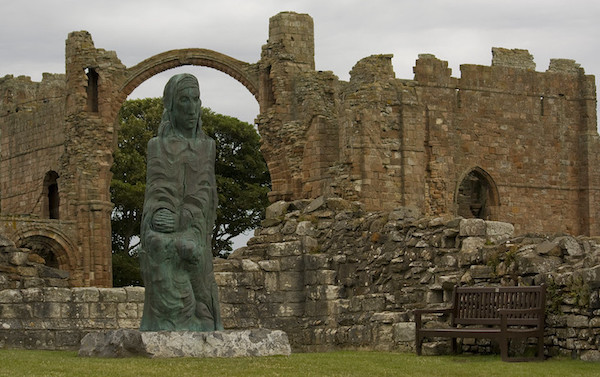St Cuthbert, whose feast day is 20 March, is one of the most likeable medieval saints. Described by Bede as “a very pleasant and affable man” he was a monk and a preacher, a bishop and a confidant of kings. A saintly healer of bodies and minds, his relics at Lindisfarne and subsequently Durham were a major pilgrimage destination.
Affection for the saint survived the Reformation and he remains to this day the patron saint of northern England.
Much of what we know of this holy man comes from a series of Lives – idealised biographies – all of which were written within a few decades of the saint’s death on this day in 687.
Born in c635, Cuthbert was a scion of the Anglo-Saxon warrior elite. As a youth, he campaigned with his fellow Northumbrians, “dwelling in camp with the army, in the face of the enemy”. His aristocratic martial background is also evoked in the description of his arrival at the monastery of Melrose in 651, on horseback, carrying a spear and attended by a servant – all attributes of Anglo-Saxon posh boys.
But by this time, Cuthbert was already a miracle worker, his prayers saving a boatload of Tynemouth Abbey monks from being swept out to sea. Cuthbert’s decision to put aside his spear and to have his head tonsured was inspired by a vision of angels accompanying the soul of St Aidan, first bishop of Lindisfarne, as it went to heaven.
At Melrose, Cuthbert found his true vocation. Bede tells how he, “excelled…in strict zeal for discipline. He watched, prayed, worked and read harder than anyone else.” The future saint also directed his energies to evangelising the populace, undertaking arduous preaching tours lasting up to a month.
He was also distinguished by his asceticism, on one occasion even wading out into the freezing sea to spend the night in prayer – the Anglo-Saxon version of a “cold shower” to quench bodily temptations. On returning to the shore, two otters “bounded out of the water” and stretched themselves before Cuthbert, and then “warmed his feet with their breath, and tried to dry him with their fur”.
Cuthbert’s social origins as much as his piety probably explain why he was soon selected to accompany Abbot Eata – another future saint – to found a monastery at Ripon and serve as its guest master. However, as adherents of Irish monastic customs, Cuthbert and his brethren were recalled to Melrose to make way for Wilfrid, a key supporter of Roman observance. Disagreements between these rival traditions, especially regarding how to calculate the date of Easter, led in 664 to the convening of the Synod of Whitby.
Cuthbert accepted its decisions to adopt Roman customs and was sent to the royal monastery at Lindisfarne to bring peace to its divided community. According to Bede, he overcame schism among the monks “by patience and forbearance, bringing them around little by little through daily example to a better frame of mind”.
Perhaps the monks’ fractiousness – an ever-present characteristic of medieval monasticism – prompted Cuthbert to retreat to the island of Inner Farne and live as a hermit, where he emulated the “Desert Fathers” of fourth-century Egypt, battling demons.
The saint built for himself an oratory and circular cell. Attached to this was a “small shed…big enough for his daily requirements” – in other words, a latrine. This was flushed by the waves which crashed into the rocks beneath. Cuthbert asked the Lindisfarne monks to provide a wooden plank on which to rest his saintly backside. This they forgot to do, occasioning one of the stranger miracles of the Middle Ages, for according to Bede, the next morning, “a piece of wood the correct length was thrown up by the tide under the site of the shed”. This prompted the negligent Lindisfarne monks to “marvel at the sanctity of a man whom the very elements obeyed.” As far as I know, it’s the only miracle to involve a lavatory seat.
Animals likewise heeded the saint’s command. A raven which Cuthbert admonished for filching the straw from the roof of his cell and oratory returned to do penance “with feathers outspread and head bowed low to its feet in sign of grief. Using whatever signs it could to express contrition it very humbly asked pardon.”
High-born abbesses turned to Cuthbert for counsel; one and was miraculously healed by contact with his belt. In 685, Cuthbert was consecrated as bishop of Lindisfarne: King Egfrith of Northumbria sailed to Inner Farne to personally beg him to take on the burden of episcopal office.
This Cuthbert fulfilled with his customary diligence. After celebrating Christmas 686 at Lindisfarne, he returned, however, to his hermitage on Inner Farne where he died on 20 March 687. His body was taken to Lindisfarne, where it was wrapped in a linen winding sheet and placed in a stone sarcophagus, which was buried in the monastic church.
Eleven years later, Cuthbert’s body was exhumed. His corpse was incorrupt and “seemed not dead but merely sleeping” – a sure sign that Cuthbert was indeed a saint. His relics were translated into a specially built wooden container, which was “elevated”, or placed, on the floor of the church.
The Lindisfarne Gospels were created in honour of the saint and may well have been exhibited in conjunction with this shrine. A series of healing miracles testified to St Cuthbert’s holiness and his fame spread across Anglo-Saxon England and beyond, pilgrims travelling to his shrine from as far away as Frisia.
Less welcome visitors arrived in 793 when the Vikings sacked Lindisfarne. This sacrilegious attack on the church of St Cuthbert sent shockwaves across Christian Europe. Its violence is recalled by the ninth-century “Viking Raider Stone” excavated at the monastery (whether or not it depicts the actual raid of 793 is open to question). Depicting fearsome looking warriors wielding swords and axes, it’s a stark reminder of the horror of these Viking attacks – not without reason, some modern scholars view the Lindisfarne raid as the “9/11” of its day.
By 875, the Viking risk was such that the monks packed up shop and left Lindisfarne, taking with them St Cuthbert’s body, the Lindisarne Gospels and other sacred treasures. They ultimately settled at Durham, where the saint’s shrine in the cathedral became one of the principal pilgrimage destinations of medieval England.
Pilgrims also journeyed to Lindisfarne, re-established as a “cell” of Durham in the twelfth century. Miracles were still being attributed to the saint in the early sixteenth century and in 1542, the commissioners sent by Henry VIII to despoil St Cuthbert’s shrine couldn’t bring themselves to destroy his relics.
To this day, they remain buried behind the high altar at Durham Cathedral, and earlier this year, English Heritage placed a new monument to mark St Cuthbert’s original resting place at Lindisfarne.



 Loading ...
Loading ...
What do you think?
You can post as a subscriber user ...
User comments (0)